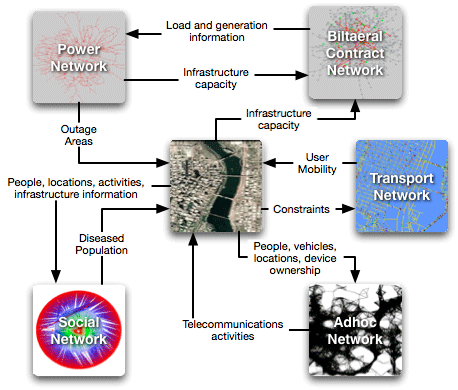This article describes our ongoing efforts to develop a global modeling, information & decision support cyberinfrastructure (CI) that will provide scientists and engineers novel ways to study large complex socio-technical systems. It consists of the following components:
- High-resolution scalable models of complex socio-technical systems
- Service-oriented architecture and delivery mechanism for facilitating the use of these models by domain experts
- Distributed coordinating architecture for information fusion, model execution and data processing
- Scalable data management architecture and system to support model execution and analytics
- Scalable methods for visual and data analytics to support analysts
To guide the initial development of our tools, we are concentrating on agent-based models of inter-dependent societal infrastructures, spanning large urban regions. Examples of such systems include: regional transportation systems; regional electric power markets and grids; the Internet; ad-hoc telecommunication, communication and computing systems; and public health services. Such systems can be viewed as organizations of organizations. Indeed, functioning societal infrastructure systems consist of several interacting public and private organizations working in concert to provide the necessary services to individuals and society. Issues related to privacy of individuals, confidentiality of data, data integrity and security all arise while developing microscopic models for such systems. See 1 2 3 for additional discussion (also see Figure 1).

The need to represent functioning population centers during complex incidents such as natural disasters and human initiated events poses a very difficult scientific and technical challenge that calls for new state-of-the-art technology. The system must be able to handle complex co-evolving networks with over 300 million agents (individuals), each with individual itineraries and movements, millions of activity locations, thousands of activity types, and hundreds of communities, each with local interdependent critical infrastructures. The system must be able to focus attention on demand and must support the needs of decision makers at various levels. The system must also support related functions such as policy analysis, planning, course-of-action analysis, incident management, and training in a variety of domains (e.g., urban evacuation management, epidemiological event management, bio-monitoring, population risk exposure estimation, logistical planning and management of isolated populations, site evacuations, interdependent infrastructure failures).






